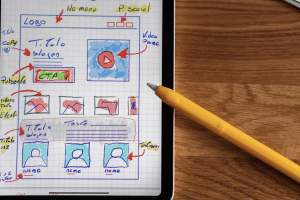Despite the numerous advantages of learning online, a generic class is unsuitable for many learners. It may take them longer to complete their studies or even force them to drop out halfway.
What these students need are personalized content and sessions, and the best way to achieve that is to introduce tools that customize everything. Below, we examine this topic in detail and highlight how such tools can increase student engagement.

How The Shift Toward Personalized Learning Tools Increases Engagement in Online Education
As more students transitioned to online learning, the lingering question was how to maintain student attention without affecting the learning experience. It was a difficult question as traditional classrooms had failed to achieve that. There were many attempts, such as improving the student-tutor ratio, but traditional classrooms could not satisfy the needs of all.
So, how was online education, including bachelor’s, master’s, and other online degrees and courses, going to do it differently? Well, they found a solution. It was as simple as personalizing the learning experience. Unlike generic tools used in traditional online studies, personalized tools increase engagement in the following ways:
Supports Diverse Learning Styles
Students have different learning styles and needs. It affects how they process information. In a traditional online course, all students get the same text-heavy model. It can also have some video lectures. They also get a course timeline indicating what to study by when and the examination areas.
However, these formats are not engaging for students who are disinterested in such media. They may have the best visuals or explanations in texts, but students may still find them almost similar to a traditional classroom, where there is practically no engagement.
Hence, the delivery method of a personalized tool helps learners absorb the knowledge in a way that suits them. For instance, visual learners want to see how a phenomenon or issue arises. If it’s a math problem, they want an explanation that captures each step of the process. They want to interact with the content through various visual elements, from charts to diagrams. They can also gain knowledge from interactive simulations in relevant fields.
On the other hand, auditory learners may benefit from a tool with a lecture recorder, as it helps them access audio explanations. Podcasts can also present recorded explanations to learners who prefer modern audio media, especially for discussion lectures. Additionally, tools like Google meeting transcription can support learners by providing both spoken content and text, reinforcing comprehension. For a kinesthetic learner, course content prioritizes action.
Hence, a learner may get exercises that require drag-and-drop actions. There may also be a scenario-based assignment to ensure active participation. Another personalized feature is adjustable playback speed to customize the pace.
Tailored Content Delivery
The traditional classroom provides the same course material to all students. One of the disadvantages is that students have different skills and paces. Thus, the course may benefit some students, but others fail to grasp concepts presented in this way.
In contrast, personalized tools adapt the content to the skill level. They also match the course material to the learning pace. Hence, when a learner shows competence in a specific concept, the platform automatically provides access to advanced material.
The platform helps students who get stuck improve their skills by offering more examples and practice exercises. It may also enhance the explanations with examples relevant to the learning level, which ensures there is always something new and exciting to learn. Therefore, it prevents boredom.

Relevance to Individual Goals
A student is likely to be more engaged in an online class when they see the connection between the study area and personal goals. Consequently, a platform with a personalized tool aligns lessons with goals. These can be personal or career goals. Hence, the platform ensures the examples of case studies used fit specific career or other goals. For instance, if a student is in the digital marketing field, lessons on data analysis may consist of campaign metrics.
On the other hand, the examples an aspiring engineer gets may focus on structural efficiency. Thus, although the core concept is similar for both students, the framing is relevant to a specific sector. Another area that can match career or personal goals is the course assignments. A student gets assignments tailored to the industry, which prepares them for the field.
Feedback and Progress Tracking
When a learner is uncertain about their progress, engagement decreases. Some eventually drop out or change courses. Therefore, personalized learning tools provide feedback and track progress. A student receives immediate feedback, information they can use to clarify their assignment mistakes.
Engagement also increases through progress tracking as it provides a visual summary of the learning process. For instance, a personalized platform can display achievements and milestones on the dashboard. These can include the number of assignments completed and the scores. It also reminds students of unattempted assignments, which increases engagement through regular visits to check due dates.
Progress tracking can also highlight how long a student took in various tasks, which can help them improve their time management. Seeing the skills mastered can also motivate a student to take on other courses.

Collaboration and Social Learning Through Personalization
Although online education puts more emphasis on individual work, enabling peer interactions can boost engagement. Thus, platforms introduce personalized tools that can match students based on skill and academic or career goals. It’s better than forming random groups with partners who barely have anything in common. As such, these tools help create suitable study groups. They can also help students organize course project teams.
For example, it can suggest two students with different, crucial skills, such as research and presentation, to work together. It helps expose each student to the other’s skills while ensuring they also sharpen individual skills. Such teams are more likely to stay active than random pairs. The platform can then prompt the group with personalized discussion questions based on team progress and interactions.
Accessibility and Inclusivity
Engagement requires a platform to accommodate all students, regardless of their abilities and backgrounds. Personalized learning tools make this possible by embedding various features into the design. For instance, some tools have text-to-speech functionality. This feature distinguishes online education from traditional classrooms.
It can help students with visual impairment adjust the content in real-time. In addition to students with such special needs, text-to-speech capability helps students with tight schedules listen to lectures while undertaking other tasks.
Another feature that may assist such students is screen reader compatibility. It makes various components of the platform and the content, such as navigation menus and hyperlinks, recognizable through assistive technology. Closed captions or translation tools can also be available. They embed text in videos for students with hearing difficulties to keep up with the speaker. Additionally, closed captions can also help students new to the language learn spellings.
A platform may also cater to specific learning difficulties. For instance, people with dyslexia may require a unique font type. These and more features enable the tool to attract a diverse pool of students, which can enrich group discussions.
Gamification Elements
Online education can become monotonous when the system uses the same modules and assessments. Thus, it can affect engagement as more students may opt to drop off in search of something more interactive. Personalizing the learning process helps, as it introduces gamification elements.
One of the common features is a level badge. A student can receive it when they complete a session and earn good grades. The badge can also be in the form of a certificate to display to their peers. Another gamification element is a progress bar.
A personalization tool can display it on the dashboard, showing how many modules a student has conquered and the remaining number. It can be a visual percentage bar that fills up as a student progresses with their studies. These elements work because they provide immediate feedback, unlike when they have to wait for an assessment exam. Additionally, the rewards are individualized, based on performance. It turns routine activities into rewarding moments.
Flexible Learning Schedules
A personalized learning tool allows students to pace the course according to their schedules. It eliminates the rigid class time common in traditional online education platforms. Adult learners can schedule specific times for work, school, or family.
Another crucial aspect of these flexible learning schedules is the ease of revisiting course material. A student can refer to previous material while revising for an exam, as it is accessible on the same tool. Additionally, they can pause a complex section to review concepts covered in a previous class. They can also skip easy sections once they master the concepts and review them later. It means the learner is in control of their studies, which increases engagement.

Predictive Personalization
Personalization does not have to wait until a learner succeeds or faces a difficulty. Using predictive personalization, a tool can anticipate what a learner may need. The tools built on artificial intelligence have advanced analytics that can identify behavior patterns. For instance, they can analyze how long a student spent on a module. They can also identify frequent errors. This data helps predict when a student is likely to lose interest in the subject matter or lag.
For example, if the data shows a student hesitates to take on specific math problems, the tool anticipates the same issue may arise in the future. Hence, it assigns exercises to prepare the student for future coursework. AI math solver, for example, could offer real-time feedback and guide the student through complex problems, helping them build confidence in their abilities. To further engage the learner, the tool may suggest alternative methods for solving the problem, ensuring that they stay motivated and on track. For students who disengage with long texts or explanations, the tool creates shorter segments to boost their attention. It can also make these sections interactive. Another potential strategy is using reminders to notify students so they do not lag.
For instance, if the data predicts a student may fail to complete a module in time, the system can send a prompt. It can be a notification to create achievable milestones. The tool can also use targeted resources to keep students on track. For example, it can give additional explanations to demystify concepts students struggle with.
Alternatively, it can add practice exercises at the level where a student has the most difficulty. Another option is presenting the course material in alternative formats. For example, the tool can share a video that simplifies the material if a student is struggling with a math concept. It can also provide a step-by-step guide.
These aren’t the only solutions. The platform can also send adaptive schedule prompts to make the sessions bearable. Hence, when a student shows signs of disengaging after attending long sessions, the tool suggests a break or a shorter session. On the other hand, if a student is engaged and motivated, the tool can send a scheduling prompt to proceed to the next session when they still have interest.
Emotional Engagement
Emotions can influence online education. Therefore, a platform must analyze how students respond. For instance, it can identify patterns like rushed clicks. A student may be rushing through out of boredom. Some also rush through because they are impatient and want to get to the next level or module.
Therefore, the platform can provide interactive material, such as simulations. Quizzes can also reduce boredom as they require a learner to think about the lesson. Rushed clicks can also suggest that a student finds some content irrelevant. Thus, the platform responds with suitable summaries.
Another way to identify emotional responses is through sentiment analysis. A tool can check for phrases in discussion posts that suggest a student is feeling discouraged. These can also be in reflection posts. Hence, the system can send supportive messages. It can also provide resources to help students understand the concepts that may be discouraging them. Another solution is notifying a human instructor to attend to these students one-on-one.
Conclusion
Engagement increases when students use personalized tools for several reasons. For instance, it tailors online education to individual needs, helping students meet personal and career goals. Additionally, these tools track progress. It motivates students to put more effort as they can see the improvements on the dashboard.
Predictive analysis also benefits learners. The tool identifies patterns that suggest a student may not continue with the coursework. It then uses various strategies to encourage learning. These may include changing the material format and sending regular reminders.
Author Bio
Lea Erastus is a tech and business blogger, always on the lookout for the latest trends and innovations. With a wealth of knowledge and insight, she’s always aiming to offer readers a unique perspective on the issues that matter most.
Last Updated on October 24, 2025 by Ash